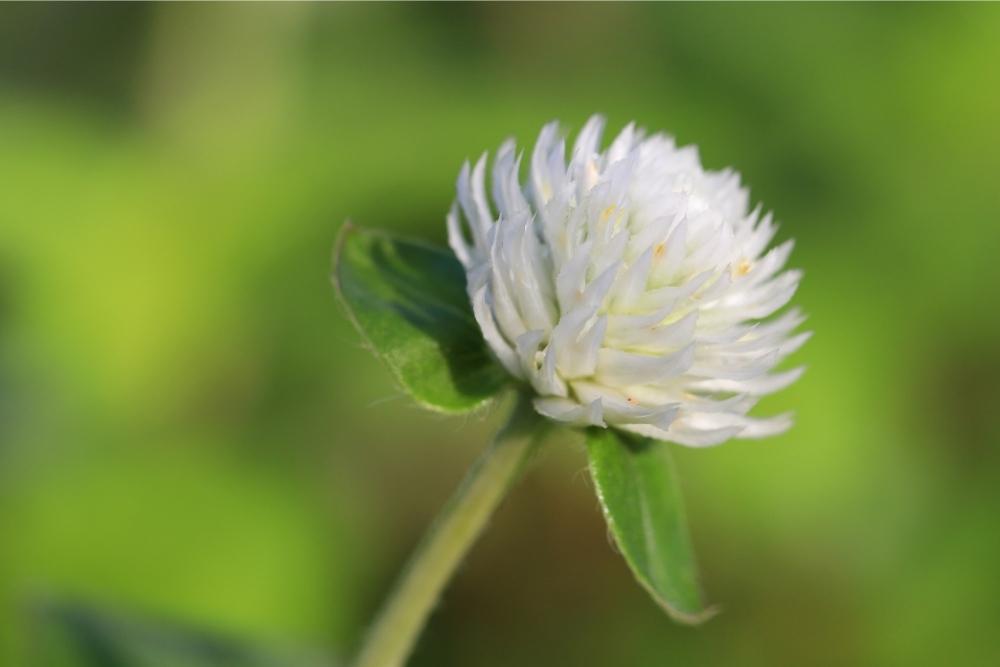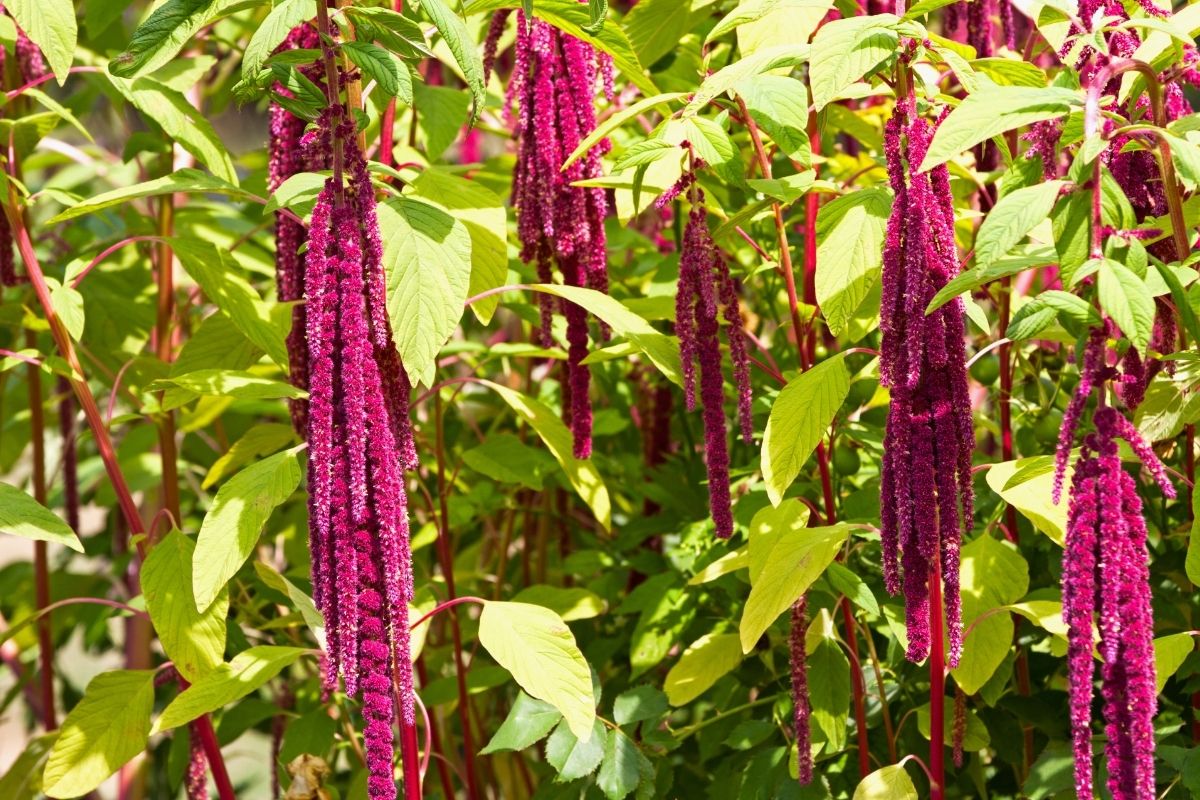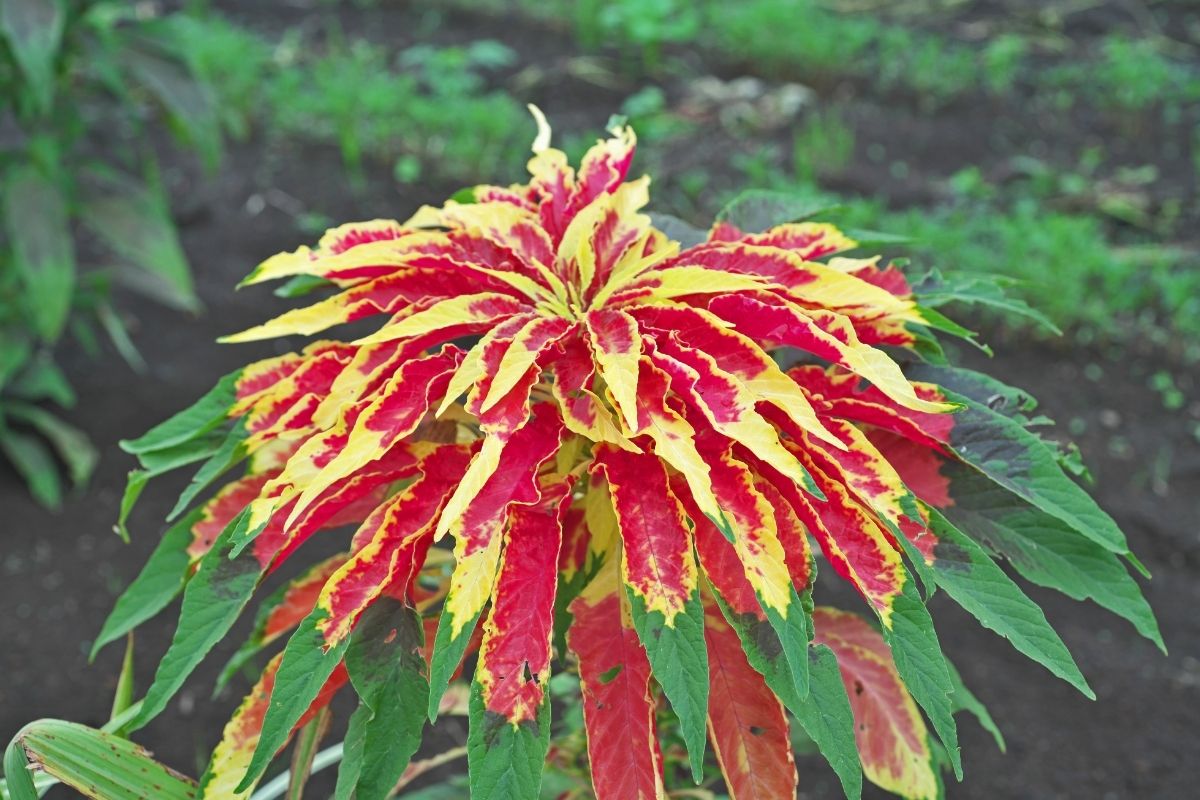
Amaranth Flowers refers to a genus of a short-lived but flowering perennial that is known within botany as Amaranthus. This genus is of the wider Amaranthaceae family which contains over 2040 similar species and 165 genera.
The Amaranth is quite an interesting flower when it comes to botanical categorisation, many describe the plant as a weed, or commonly pigweed as it is used to feed pigs and other agricultural cattle. This is thanks to the plants’ many edible parts which are commonly edible for humans too.
The amaranth grain is described as a pseudocereal, rather than a true cereal such as wheat or rice. The grain is edible to most species.
Although, of most interest to us right now, the Amaranth is a flowering perennial plant that has an interesting inflorescence leading it to be grown also for its ornamental qualities as well as its potential for food.
They can vary quite widely in terms of inflorescence but generally have a hollow and cylindrical stem that can grow up to 3.5m in some species. From this stem, multiple small and dense panicles emerge with some striking colors.
The amaranth is used widely by gardeners and landscapers for its different but interesting inflorescence that will stand out among your usual flowering perennials. This is a good place to look to do something different with your garden this summer.
1. Amaranthus caudatus ‘Coral Fountain’
Interestingly, this species is an heirloom variety, this means the plant’s genetics have been isolated and cultivated for a long time as a provision. However, this plant also has some beautiful inflorescence which has also led it to be cultivated for purely ornamental purposes.

The cymes hang downwards from the stem and are long and densely packed. ‘Coral Fountain’ is an apt name as the crimson cymes flow down from the stem like a waterfall of red color.
These are popular among florists and are often used in flower arrangements or even in bouquets for a pop of color and a little bit of a different inflorescence rather than your common petal. The plant can grow to around 5 feet so it is a great way to add height to borders and beds.
2. Amaranthus cruentus ‘Autumn’s Touch’
Autumn simply means Fall for Europeans, and that is the vibe that you get from this plant’s inflorescence. Expect gold and yellow colors from the plants long and erect cymes. In comparison to the ‘Coral Fountain’ cultivar, this variety stands tall rather than hanging down.

One great thing about this is that you don’t need to worry about tying the plant up to stop it drooping, the stems are super thick and strong enough to stand strong on their own.
There’s no surprise this cultivar has won the Royal Horticultural Society’s Award of Gardening Merit, as when mature the plant really stands to be a spectacle in your garden.
Beyond its striking inflorescence, the plant has some bold and dark green leaves that are quite wide and provide a great contrast to the bright flowers of this cultivar.
3. Amaranthus cruentus ‘Hopi Red Dye’
Another cultivar that can really demonstrate the variety of use and both foliage and inflorescence of the Amaranthus genus. This specific cultivar is aptly named ‘Hopi Red Dye’ as the flowering part of this perennial is used to make dyes. Not only this but the young leaves, as well as seeds and grains, are all edible. This cultivar is particularly good in a North American climate.

In addition to the plant’s wide usages, its flowering part is also ornamental. The cymes stand tall on the thick and erect stems that can withstand most weather conditions without aid. They have a very dark purple-red color that makes a dense flower of magenta colors.
Perhaps most interesting is the plants’ similarly dark red foliage that is really striking in comparison to the flowers. This is a really great way to bring a pop of dark color to the bright color of your beds and can help complement these brighter plants in a bed. While this plant is slightly smaller than other Amaranth cultivars it definitely makes up for it with its bold colors.
4. Amaranthus hypochondriacus ‘Green Thumb’
This is a particularly unique Amaranth cultivar that is a much more compact and shrub-like variety that grows to around 2 feet tall. Although small, the plant does stand tall and erect rather than drooping. It is particularly enjoyed by pollinators for its flowers which are rich in nectar and pollen.

The plant has some interesting inflorescence as its cymes are made up of compact green flowers that create a long and dense inflorescence that is unusually green.
Moreover, the plant has some bright green foliage made up of ovate leaves which can also provide a great backdrop to complement other bold colors. This makes it perfect for complimenting other Amaranths that have striking colors. Its green color means it is also good to bring some variety to a flower bouquet or even a bed or border that has a lot of bold colors in it.
5. Amaranthus tricolor ‘Perfecta’
Interestingly, this variety is often cultivated for its foliage rather than its inflorescence. However, we still felt it was right to include this not only as the foliage can have the same effect as a beautiful flower, but because the foliage goes a long way to compliment other flowers within a bed.

The foliage is a striking display of yellow and red to purple colors all within one leaf. What’s more, each seed and the individual plant will have its own unique display of these colors and can change depending on the richness of the soil and the optimisation of growing conditions.
The foliage makes a perfect or ‘perfecta’ backdrop for any garden bed. It’s likely that the interesting foliage colors are caused by variegation.
6. Amaranthus cruentus ‘Hot Biscuits‘
This is another cultivar that is a striking feature of any garden, the contrast between boldly green foliage and bright orange flowers make a perfect addition to borders and flower beds as well as adding a pastoral vibe to a bouquet.

They look great in beds as they grow pretty high to over 4 feet in some situations. While the flower starts off as quite bright and orange like wheat or grass, when they flower into seeds the cultivar becomes quite bronzy, so it’s nice to watch the colors change as the season goes on.
7. Amaranthus tricolor ‘Joseph’s Coat’
Again, Amaranthus tricolor is often grown for its foliage rather than its flower. But with the ‘Joseph’s coat’ cultivar, you can really see why. In comparison to the ‘Perfecta’ tricolor cultivar, ‘Joseph’s Coat’ is a little more drastic in the color variation.

The leaves start off green but many mature versions of the plant boast very dark foliage to some incredibly bright red colors that are almost neon.
The plant is cleverly named after the biblical story of Joseph and his technicolor dream coat, which is making reference to the eye-catching colors on this plant and its ability to stand out within your garden.
Utilising the tricolor variety can really show your nuance as a gardener, not just relying on flowers to catch the attention of the passer-by. To really get the most from the color of the foliage, limit fertilizer as this often has the greatest effect on reducing the color of the foliage. Increasing sun exposure will increase the color differences and their brightness.
The Final Say
As we have demonstrated, the Amaranth is one of the most versatile and interesting plants out there and is often overlooked for its usage within the food industry. While the plant has much food uses thanks to its grains and edible foliage, used commonly as a vegetable in Caribbean cuisine, there are many more uses of the Amaranth plant.
Not only can they occasionally be used as dyes (depending on the cultivar) but their flowers, which are also edible, have some really cool variation across the genus.
The Amaranthus genus should not be overlooked for its ability to add a lot of color to your borders and beds and also add some different inflorescence to your garden.
Moreover, they are also a favorite among florists who really enjoy the variation they bring to bouquets. If you really want to show off your plant knowledge, utilising the tricolor variety for its foliage rather than its flowers can show you really know your stuff when it comes to flower arrangements, and is a genus you will always keep in your arsenal.
A fun way to utilise the Amaranth, if you are a particular fan of their inflorescence is to make a bed that is specifically made up of different Amaranth cultivars, this can look really striking and can display the full variation the genus has to offer and can help others enjoy the plant too.
Amaranthus generally have a cosmopolitan distribution, meaning that they grow commonly around the world, so simply find a cultivar that will suit your garden’s conditions and get growing to show off your garden to your neighbour.







